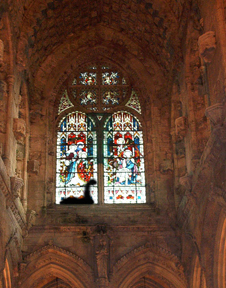
Nessie and Rosslyn – closer together than you might think…
No, I haven’t lost the plot. I’m just looking to coin a new expression; the ‘Nessie Effect’. This is when a heritage site embraces unsupported speculation in order to pay the bills. At Loch Ness it’s a real boost to the local economy. In the ’90s, it was on the order of $36 million dollars a year (rather less now admittedly). The downside is (arguably) that this level of focus on a piece of mythology (represented as plausible fact) distracts from the real treasures of the region and the country. But this isn’t really about Nessie. For that, you’d best head here or back to Google. No, I’m suggesting that the same phenomenon applies to many sites in Britain, but specifically Rosslyn Chapel (subject of many of my past posts).
I may spend a fair bit of time criticising unfounded claims about the past, but I recognise that they can bring in a lot of money that can benefit important sites like Rosslyn Chapel. It’s an ethical dilemma really. As a custodian of a cultural or historic thing, do you steadfastly stick to the known facts and struggle to get by? Or do you “sell out” by entertaining alternative history in order to keep the money rolling in?
I think the answer is to strike a balance. The Rosslyn Chapel Trust stock both serious and speculative books in the gift shop, and of course fiction like the Da Vinci Code. This does allow visitors to make up their own minds, and makes money from different audiences at the same time. Unfortunately, they go further and allow events like the live performances of the so-called Rosslyn Motet. You could argue that this is little different than a museum hosting a corporate event within its galleries, but the difference is that the latter do not passively endorse dubious claims about its exhibits.
For me, the Rosslyn approach is simply too uncritical, too laissez-faire. But from their perspective – why bite the hand that feeds? I really can’t blame them for it. But what does it say about your attitude to your visitors when you do this? Aren’t you casting them as gullible punters to be herded in, harvested for money, and sent on their way none the wiser? I for one would rather visitor centres strive toward fact-based interpretation as accredited museums are obliged to do.
But I’m just an armchair commentator. It’s not easy running a site like Rosslyn without significant external funding. And it’s clear that their approach has worked as far as increased visitor numbers and income, as this Scotsman article details. It remains to be seen whether this is used to its fullest potential.
Besides, let’s not forget the media’s role in peddling the pseudohistory that places like Rosslyn take advantage of. On that score, I was pleased to see from the linked article that the Scotsman has moderated its tone regarding the musical cubes ‘discovery’ that it reported on rather uncritically in 2005. The following year it even suggested that when the music was played, it might unlock a lost secret. I wrote a series of posts debunking these claims – see also Jeff Nisbett’s definitive article. Pleasingly, the latest media mention as linked above, is this:
Among Rosslyn’s many intricate carvings are a sequence of 213 cubes or boxes protruding from pillars and arches with a selection of patterns on them. It is unknown whether these have any particular meaning.
Many people have attempted to find information coded into them, but as yet no interpretation has proven conclusive.
Now that’s how to report speculative history. I wish more of those in charge of the UK’s cultural landmarks were so circumspect.